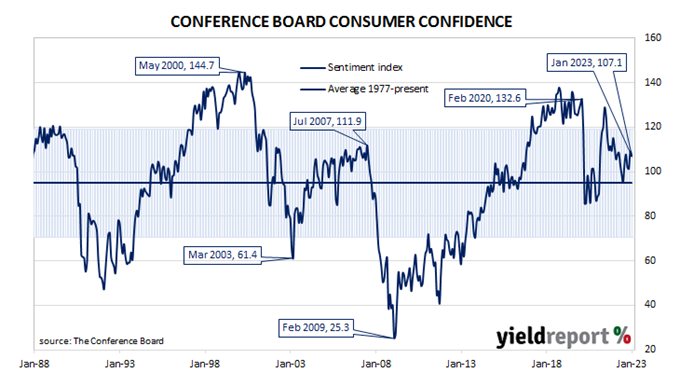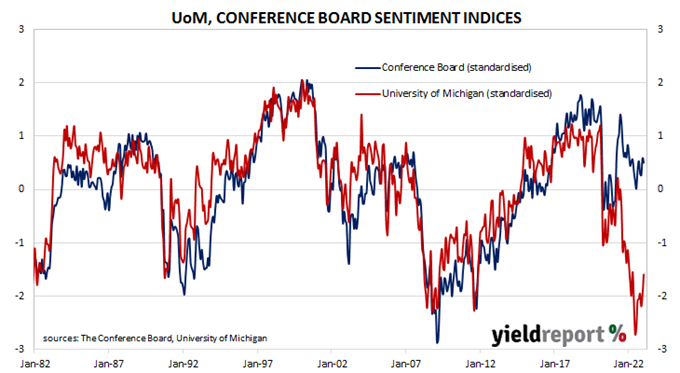Summary: Conference Board Consumer Confidence Index falls in January, reading less than expected; contrasts with recent UoM survey; views of present conditions improve, short-term outlook deteriorates; Expectations Index decline due to jobs, broader US economy.
US consumer confidence clawed its way back to neutral over the five years after the GFC in 2008/2009 and then went from strength to strength until late 2018. Measures of consumer confidence then oscillated within a relatively narrow band at historically high levels until they plunged in early 2020. Subsequent readings then fluctuated around the long-term average until March 2021 when they reached elevated levels. However, a noticeable gap has since emerged between the two most-widely followed surveys.
The latest Conference Board survey held during the first three weeks of January indicated US consumer confidence has deteriorated slightly. January’s Consumer Confidence Index registered 107.9 on a preliminary basis, lower than the expected figure of 109.0 and down from December’s final figure of 109.0.
NAB Head of Markets Strategy Skye Masters said, “This result contrasts to the lift recently seen in the University of Michigan measure but is likely to reflect concerns around the labour market given recent company layoff announcements…”
US Treasury yields generally finished the day lower with the exception of ultra-long yields which moved noticeably higher. By the close of business, the 2-year Treasury bond yield had lost 3bps to 4.21%, the 10-year yield had shed 3bps to 3.51% while the 30-year yield finished 13bps higher at 3.64%.
In terms of US Fed policy, expectations of higher federal funds rates over the next 12 months softened. At the close of business, contracts implied the effective federal funds rate would average 4.58% in February, 25bps higher than the current spot rate, and then climb to an average of 4.65% in March. May futures contracts implied a 4.89% average effective federal funds rate while December contracts implied 4.555%.
Consumers’ views of present conditions improved while their views of the near-future deteriorated. The Present Situation Index increased from December’s revised figure of 147.4 to 150.9 while the Expectations Index declined from a revised figure of 83.4 to 77.8.
Ataman Ozyildirim, a senior director of economics at The Conference Board, said the decline in the Expectations Index was due to jobs and the broader US economy. “Consumers were less upbeat about the short-term outlook for jobs. They also expect business conditions to worsen in the near term.” However, he also noted “consumers expect their incomes to remain relatively stable in the months ahead.”
The Consumer Confidence Survey is one of two widely followed monthly US consumer sentiment surveys which produce sentiment indices. The Conference Board’s index is based on perceptions of current business and employment conditions, as well as respondents’ expectations of conditions six months in the future. The other survey, conducted by the University of Michigan, is similar and it is used to produce an Index of Consumer Sentiment. That survey differs in that it does not ask respondents explicitly about their views of the labour market and it also includes some longer-term questions.



